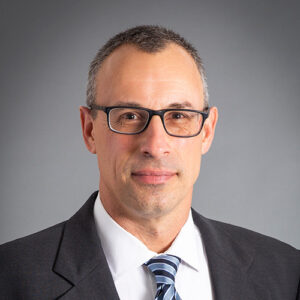 In July 2023, Tyler Prout, MD was appointed as the vice chair of quality and safety in the Department of Radiology. While Dr. Prout has a history of prioritizing quality and safety in the department – he’s served as the associate vice chair since 2017 – his interest in the subject goes back to before he became a radiologist.
In July 2023, Tyler Prout, MD was appointed as the vice chair of quality and safety in the Department of Radiology. While Dr. Prout has a history of prioritizing quality and safety in the department – he’s served as the associate vice chair since 2017 – his interest in the subject goes back to before he became a radiologist.
Dr. Prout was in the Navy from 1997 to 2002, where he was a naval flight surgeon. Part of his training for that role was in aviation mishap investigation. “Our primary focus was understanding the human factors that contribute to a mishap,” says Dr. Prout. “That stayed with me when I came through radiology residency here.”
As associate vice chair, he took steps to improve quality and safety in the Community section. One example was the implementation of software in ultrasound reporting called Modlink. Traditionally, the measurements in an ultrasound report needed to be dictated into the report by the radiologist. However, this clerical task is both time-consuming and prone to voice recognition errors. Adoption of the Modlink solution to automatically populate templated reports both increased radiologist efficiency and report accuracy. The solution was eventually adopted by the Abdominal Imaging and Intervention section.
“We created templates so those numbers would be imported directly from the ultrasound machine to our report,” says Dr. Prout. This made the process more efficient and less prone to mistakes. The system was eventually adopted by the Abdominal Imaging and Intervention section, too.
In his new role as vice chair, Dr. Prout is focused on bringing best practices on how to handle actionable incidental findings (AIFs) to not only the Community section but across the entire department. The Community section has had a robust closed loop tracking system in place for incidental findings such as pulmonary nodules or indeterminate renal masses which could be early cancers now for several years. Since inception there have been over 9,000 entries and several incidental cancers detected that may have otherwise been lost to follow up. Piloting the program was possible due to Robert Bour, MD and Newrhee Kim, MD securing a grant to fund a reading room assistant to assist with tracking. Due to its success, Dr. Prout it interested in broadening the program across the entire department.
“Making sure these AIFs don’t slip through the cracks is good for the healthcare system, it’s good for the hospital, and it’s good for the patient,” says Dr. Prout. I would change order – “it’s not only good for the patient, but good for the hospital and healthcare system as a whole”.
He’s also hoping to improve – and standardize – the peer-learning practices in the Department of Radiology. In the Community Section, they have a monthly conference where they discuss difficult cases, near misses, and great catches. “When we all learn together, all boats rise,” says Dr. Prout. In the future, he aims to establish a point person for quality and safety in each section.
“I’m try to take what’s out there – the best practices – and bring them here,” he says. “To err is human, but how can we make the system safer?”